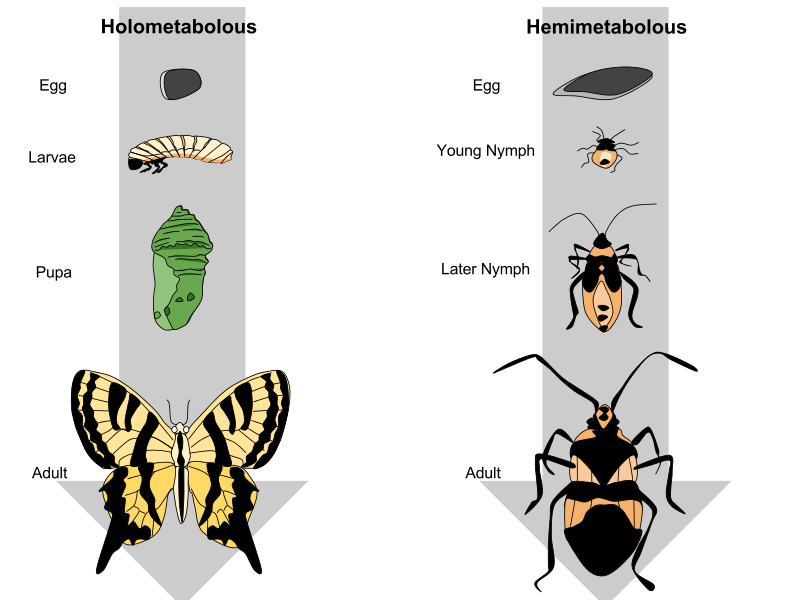Difference Between Ametabolous and Hemimetabolous
The key difference between ametabolous and hemimetabolous is that ametabolous refers to insect development in which there is no metamorphosis while hemimetabolous refers to insect development in which there is incomplete or partial metamorphosis.
Metamorphosis is a series of events by which insects develop, grow and change the form. In simple words, it is the series of changes occurring in insect forms – from eggs to immature stages to adult stages. Insects with complete metamorphosis undergo all four stages: eggs, larvae, pupa, and adult. Insects with simple or incomplete metamorphosis undergo only three stages: egg, nymph and adult. Some insects do not show metamorphosis. There are three groups of insects based on metamorphosis. They are ametabolous, hemimetabolous and holometabolous. Ametabolous insects do not show metamorphosis while hemimetabolous insects show partial metamorphosis.
CONTENTS
1. Overview and Key Difference
2. What is Ametabolous
3. What is Hemimetabolous
4. Similarities Between Ametabolous and Hemimetabolous
5. Side by Side Comparison – Ametabolous vs Hemimetabolous in Tabular Form
6. Summary
Ametabolous refers to insect development without metamorphosis. Therefore, insects are said to be ametabolic when there is no metamorphosis. In ametabolic insects, the young insect that hatches from the egg is a miniature of the adult. They differ from the adult by having immature reproductive organs.

Figure 01: Ametabolous Insect
After several moltings and growth, immature stages become adults. Therefore, immature stages are very similar to adults. In other words, immature ametabolous insects look like tiny versions of their adult counterparts. Lower insects such as springtails, silverfish, and firebrats are ametabolous.
Hemimetabolous describes the insect development via partial metamorphosis or simple metamorphosis. These insects have three stages in their life cycles. They are eggs, nymph and adult. Nymphs resemble their adults. Moreover, nymphs exhibit similar behaviours and typically share the same habitat and food as adults.

Figure 02: Holometabolous vs. Hemimetabolous
The change of nymph to adult is a gradual process. Appendages, mouthparts, antennae and legs of the nymph grow directly into those of the adult. Insects such as grasshoppers, mantids, cockroaches, termites, dragonflies, and all true bugs are hemimetabolous insects.
- Ametabolous and hemimetabolous are two of the three types of insects based on metamorphosis.
- Both types have two common stages: eggs and adults.
Ametabolous describes the insect development in which insects do not show metamorphosis. Meanwhile, hemimetabolous describes the insect development in which insects show partial metamorphosis. So, this is the key difference between ametabolous and hemimetabolous. For example, the most primitive wingless insects such as silverfish are ametabolous insects. Whereas, grasshoppers, true bugs, aphids, and scale insects with a winged adult with fully developed genitalia are hemimetabolous insects.
Below infographic summarizes the differences between ametabolous and hemimetabolous in tabular form.

Summary – Ametabolous vs Hemimetabolous
In short, ametabolous and hemimetabolous are two types of insect groups based on the metamorphosis. In ametabolous insects, only a gradual increase in the size of immature stages can be seen until becoming adults. They do not show metamorphosis. Silverfish, springtail, and other primitive insects are ametabolous insects. In contrast, hemimetabolous insects show partial metamorphosis. Their life cycle has three stages: eggs, nymphs and adult. In here, the nymphs resemble adults. Nymphs become adults after moulting and growth. Grasshoppers, mantids, cockroaches, termites, dragonflies, and all true bugs are hemimetabolous insects. Thus, this summarizes the difference between ametabolous and hemimetabolous.
Reference:
1. “Metamorphosis in Insects (With Diagram).” Biology Discussion, 2 May 2016, Available here.
2. “Natural History.” Encyclopædia Britannica, Encyclopædia Britannica, Inc., Available here.
Image Courtesy:
1. “Lépisme argenté” By Jean-Raphaël Guillaumin (CC BY-SA 2.0) via Flickr
2. “Holometabolous vs. Hemimetabolous” By Username1927 – Own work (CC BY-SA 4.0) via Commons Wikimedia
ncG1vNJzZmivp6x7pbXFn5yrnZ6YsqOx07CcnqZemLyue8OinZ%2Bdopq7pLGMm5ytr5Wau26tzJ6rmpqfoby2v4yapZ1lmJq6qrnErZibp5ykwrR7